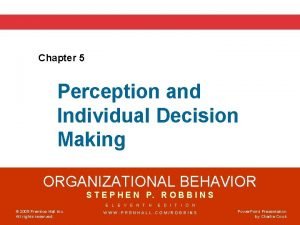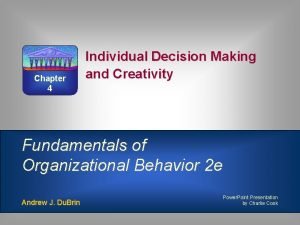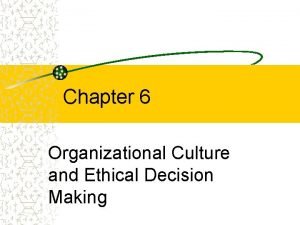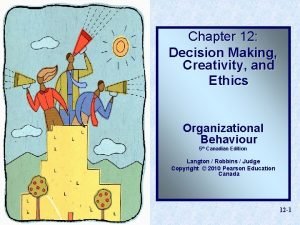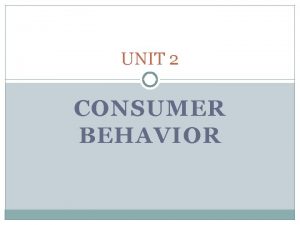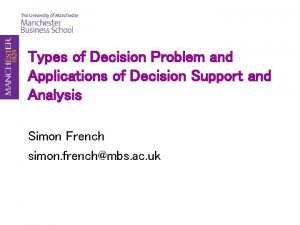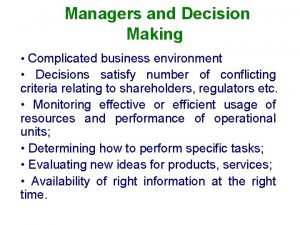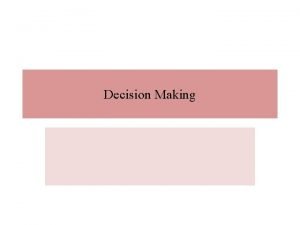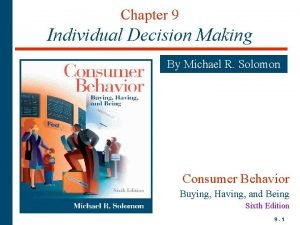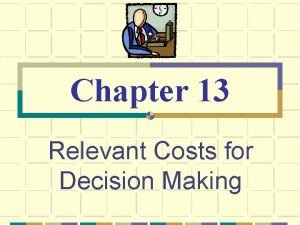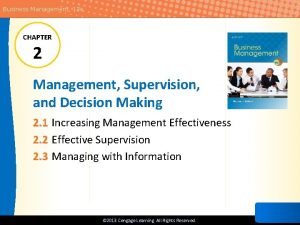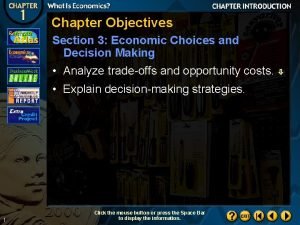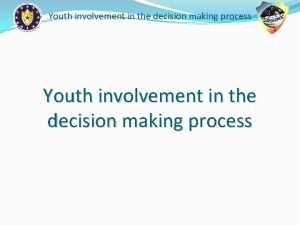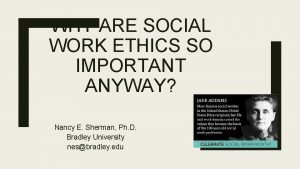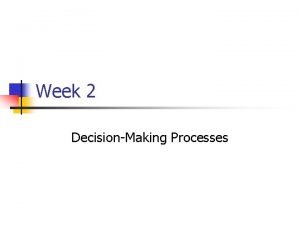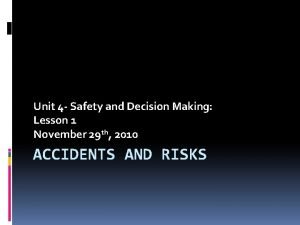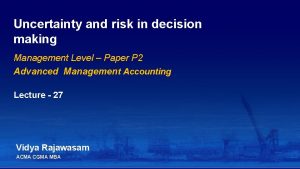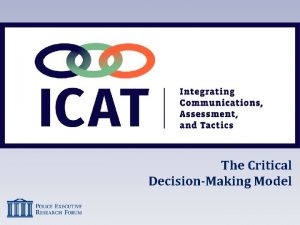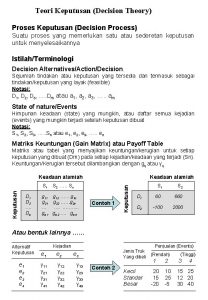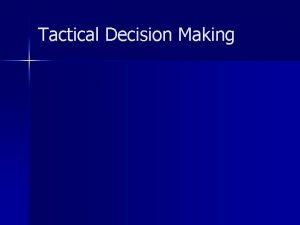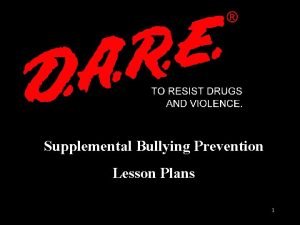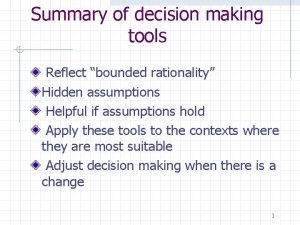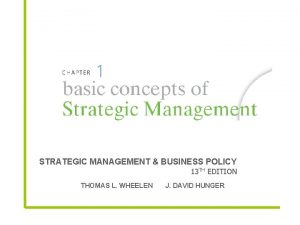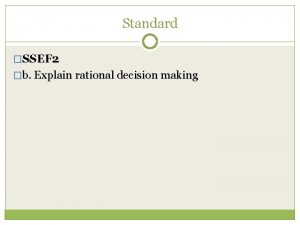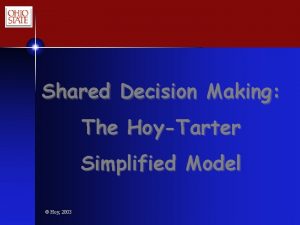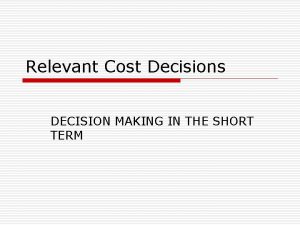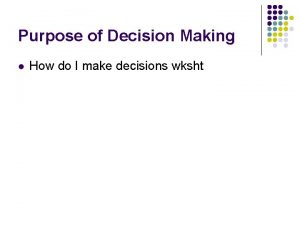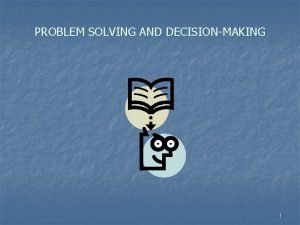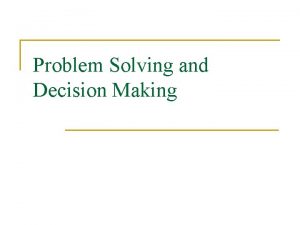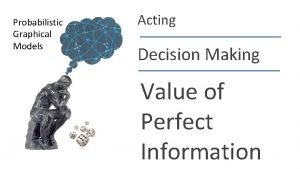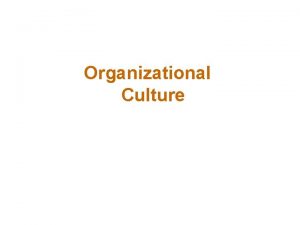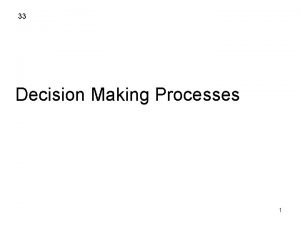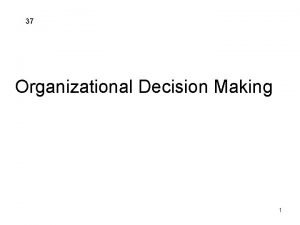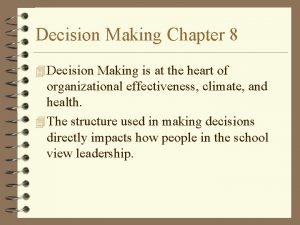CHAPTER 8 DECISION MAKING Organizational Decision Types Decision

























































- Slides: 57

CHAPTER 8 DECISION MAKING

Organizational Decision Types • Decision making is the most central activity of management, the essence of a manager’s job • Two classifications: – Personal versus organizational – Programmed versus nonprogrammed

Personal v. Organizational Decision Making • Personal decision making: making decisions that involve only ourselves • Organizational decision making: involves decisions that pertain to the problems and practices of a given organization • The difference between personal and organizational decision making lies in the object of the process

Programmed v. Nonprogrammed Decision Making • Proposed by Herbert Simon • Programmed decisions: well-structured • Nonprogrammed decisions: poorly structured

Personal/Organizational Categorization • Personal programmed decisions: involve simple, repetitive personal matters • Personal nonprogrammed decisions: arise during rare but significant events in an individual’s life

Personal/Organizational Categorization (cont. ) • Organizational programmed decisions: typically handled according to established guidelines, rules, or procedures, and are most often made by lower level employees

Personal/Organizational Categorization (cont. ) • Organizational nonprogrammed decisions: rare and unique situations that have potentially significant impact on the organization, and are usually handled by high-level personnel

Classical Decision Theory • Referred to as the Rational-Economic Model • Described as a series of steps that a decision maker should follow in order to enhance the probability of attaining a desired goal

Classical Decision Theory (cont. ) • Does a good job of describing how a decision should be made, but it is largely inaccurate as a description of how managers actually do make decisions

Steps in Classical Decision Theory • Opportunity or problem of situation exists • It is recognized to exist; very important • Opportunity/problem is defined • Alternatives are generated • Information is gathered • Alternatives are evaluated

Steps in Classical Decision Theory (cont. ) • One alternative is selected • Alternative is implemented and evaluated in terms of effectiveness

Problems with the Model • It assumes that all alternatives will be considered • It assumes that the consequences of each alternative will be explored • It assumes that information is available at no cost

Problems with the Model (cont. ) • It assumes that decision makers are totally rational • In reality, the above assumptions rarely exist

A Behavioral Theory of Decision Making • Acknowledges the real-world limitations on manager’s decision making • Managers in this model operate with bounded rationality in making decisions • Recognizes that: – All possible alternatives and their associated consequences cannot be generated

A Behavioral Theory of Decision Making (cont. ) – Both the available information and the definition of the situation are likely to be incomplete and inadequate to some degree – The final decision may be based on criteria other than simple optimization or outcome maximization • When managers seek solutions that are “good enough” they satisfice, rather than maximize

A Behavioral Theory of Decision Making (cont. ) • Bounded discretion: suggests that optimal solutions are sometimes not feasible courses of action because they are ethically improper • People often use rules of thumb, or heuristics, when making decisions which are simplified decisions to achieve satisficing solutions

Influence of Judgmental Strategies • Used when decision makers go beyond the information they are given when making inferences • Often lead to erroneous inferences • Two types of judgmental strategies – Availability heuristics – Representativeness heuristics

Types of Judgmental Strategies • Availability heuristics: reflect the influence of the relative availability of objects or events, i. e. , their accessibility via memory, perception, or imagination • Representativeness heuristic: the application of one’s sense of resemblance between objects or events

Obstacles to Effective Decision. Making • Four most common obstacles: – Judgmental biases – Escalation of commitment – Groupthink – Willingness of groups to take risks

Judgmental Biases • • Implicit favorite bias Loss-aversion bias Selective perception bias Personal experience bias

Escalation of Commitment • Occurs when a decision maker is unwilling to change a course of action despite unequivocal evidence showing that the decision was incorrect • Possible reasons for escalation of commitment: – Stick-to-it-iveness – Desire to be consistent

Escalation of Commitment (cont. ) • Escalation of commitment is most likely to occur in certain predictable settings, e. g. , when a person is making a decision for which she feels strong personal responsibility

Escalation of Commitment (cont. ) • To counter escalation of commitment, Barry Straw recommends seeking counsel from trusted advisors who don’t feel the personal responsibility, or alternatively, rotate responsibility across managers

Groupthink • Identified by Irving Janis in which groups are lead to commit serious errors in decision making

Groupthink (cont. ) • Characteristics of a group suffering from groupthink: – Group likely to be very cohesive – Group is more concerned with achieving consensus that it is with exploring alternative courses of action, and analyzing the situation

Main Symptoms of Groupthink • • Illusion of invulnerability Rationalization Assumption of morality Negative stereotyping

Main Symptoms of Groupthink (Cont. ) • • Pressure to Conform Self-censorship Illusion of unanimity Mindguards

Preventing Groupthink • Encourage group members to voice their opinions, doubts, objectives • Assign several group members to teams that will investigate the advisability of alternative courses of action; followed by a debate • Appoint a group member to serve as a devil’s advocate at each group meeting

Preventing Groupthink (cont. ) • Hold last-change meetings at which members are encouraged to raise any nagging doubts or hesitations that they have • As a manager, set an example by being open to criticism yourself

Risk Taking • James Stoner investigated the differences between group and individual decision making • Findings: – Individuals tend to take a less risky route, while groups favor riskier actions

Risk Taking (cont. ) – When individuals are placed in a group, they endorsed a riskier position than they did as individual decision makers, called the risky shift – Risky shift: When a group endorses a riskier position than would its individual members – Groups may diffuse responsibility, feel less personal responsibility for the consequences of their actions

Risk Taking (cont. ) – Group decision making may be more conservative than individual decision making, called the cautious shift – Tendency of groups to move toward extremes has been termed group polarization

Techniques for Improving Decision Making • Research comparing group decisions with individual decisions has shown that groups will out perform individuals working in isolation • The group’s decisions are usually of higher quality than the average of the individual decisions

Techniques for Improving Decision Making (cont. ) – The best solitary worker may often out perform the group • Reasons for groups out performing individuals include: – Groups pool information and abilities; access is greater than individual – Being in a group tends to motivate and inspire group members

Techniques for Improving Decision Making (cont. ) – Social rewards (e. g. praise, admiration) for making significant contributions • Groups may, at their discretion, exercise division of labor by breaking down task for subgroups to work on together

Problems Encountered with Group Decision Making • Groupthink • Groups may polarize toward extreme points of view if risk is involved • Groups may exert pressure on a manager that would allow escalation of commitment to occur

Problems Encountered with Group Decision Making (cont. ) • Tends to be much more costly • Group decisions tend to be influenced by the relative status of individual group members

Nominal Group Technique • Used to mitigate the potential problems associated with group decision making • Involves grouping seven to ten people • Members silently and independently record their ideas about how to tackle a problem

Nominal Group Technique (cont. ) • Each member presents one of his or her ideas to the group, and it is summarized and recorded on a chalkboard or wall chart without review of its merits • A discussion of all ideas is held and ideas are clarified and evaluated

Nominal Group Technique (cont. ) • Individuals silently and independently vote on each idea, which may involve ranking or rating in some way

Nominal Group Technique (cont. ) • Nominal group technique avoids some of the problems of traditional decision making; decisions can be reached in a reasonable amount of time without being greatly influenced by the leader’s preferred position

Delphi Technique • Similar to NGT, however, decision makers never meet • Group is selected based on expertise in given problem area • Experts are mailed questionnaires that survey their opinions

Delphi Technique (cont. ) • Experts’ responses are analyzed and distilled • Summarized results are mailed to experts and responses are requested for another, new survey; experts with dissenting opinions may be asked to rationalize their opinions, and the rationale may be sent to other experts for comment

Delphi Technique (cont. ) • Process is to be repeated several times; consensus is usually reached due to the multiple iterations

Pros/Cons of Delphi Technique Pros • Avoids biases and obstacles associated with interacting groups • Generates fairly useful information and high-quality solutions Cons • Time consuming. May take as little as several weeks or as much as several months • Highly structured format doesn’t offer much flexibility if conditions change

Social Loafing • Refers to when an individual in a group slacks off because of being in the group • More problematic in larger groups because less notability and responsibility

Stepladder Technique • Stepladder technique may combat social loafing • Groups using the stepladder technique have been found to make higher-quality decisions than conventional groups

Creativity and Decision Making • Many problems require creative solutions, particularly those that are nonprogrammed and involve broad ranging ramifications

Characteristics of Creative Individuals • Most people reach creative peak between ages of 30 and 40 • Peak creative age varies by discipline • People can still make creative contributions at later ages, however the frequency of creative productivity decreases

Characteristics of Creative Individuals (cont. ) • Creative people typically have a wide range of interests • Randsepp’s conclusions about the characteristics of creative people: – Willing to give up immediate gain to reach long-range goals – Have lots of energy – Are irritated with the status quo

Characteristics of Creative Individuals (cont. ) – Have a lot of perseverance – Pursue hobbies and specialized interests – Believe that fantasy and daydreaming are not a waste of time • Creative people are more likely to change jobs frequently

Measurement of Creativity • Ways to measure creativity include: – Direct observation – Creativity tests

Steps in the Creative Process • • • Opportunity or problem recognition Immersion Incubation Insight Verification

Methods of Enhancing Creativity • • Nominal Group Technique Delphi Technique Brainstorming Grid analysis

Du. Brin’s Suggestions for Enhancing Creativity • Don’t be afraid to try and then fail • Let your playful side come out; number of new ideas is what counts • Identify your creative time period; use humor • Borrow ideas; give rise to new ideas • Maintain an idea notebook; record flashes of insight for future reference

Ethics in Decision Making • Ethical conduct may offer a strategic advantage relative to competitors • Some organizations provide ethics training for their managers • Ethics training consists of: – Statements from top company officers emphasizing ethics in decision making

Ethics in Decision Making (cont. ) – Discussion of corporate code of conduct – Procedures for reporting unethical conduct • Ethics training can be conducted through case discussion and exercises
 Perception and individual decision making
Perception and individual decision making Decision making and creativity organizational behavior
Decision making and creativity organizational behavior The role of corporate culture in ethical decision making
The role of corporate culture in ethical decision making Individual decision making in organizational behaviour
Individual decision making in organizational behaviour Types of decision making
Types of decision making Unstructured decision
Unstructured decision Types of decision making
Types of decision making Types of decision making in management
Types of decision making in management Types of decision making
Types of decision making Types of decision making
Types of decision making Objectives of decision making
Objectives of decision making Dividend decision in financial management
Dividend decision in financial management Chapter 6 prices and decision making assessment answers
Chapter 6 prices and decision making assessment answers Steps in decision making
Steps in decision making Chapter 2 economic systems and decision making answer key
Chapter 2 economic systems and decision making answer key Management chapter 5 planning and decision making
Management chapter 5 planning and decision making Financial decision making process
Financial decision making process Chapter 2 economic systems and decision making
Chapter 2 economic systems and decision making Chapter 2 decision making
Chapter 2 decision making Relevant cost for decision making solution chapter 13
Relevant cost for decision making solution chapter 13 Chapter 2 economic systems and decision making
Chapter 2 economic systems and decision making Chapter 11 decision making and relevant information
Chapter 11 decision making and relevant information Chapter 2 management supervision and decision making
Chapter 2 management supervision and decision making Relevant information for decision making
Relevant information for decision making Management chapter 5 planning and decision making
Management chapter 5 planning and decision making Chapter 1 section 3 economic choices and decision making
Chapter 1 section 3 economic choices and decision making What is inference
What is inference War making and state making as organized crime summary
War making and state making as organized crime summary Youth involvement
Youth involvement Frederic reamer ethical decision making model
Frederic reamer ethical decision making model Systematic decision making process
Systematic decision making process Paced decision making
Paced decision making Mamdm
Mamdm Using functions in models and decision making
Using functions in models and decision making Paced decision making
Paced decision making Unit 4 lesson 1 decision making
Unit 4 lesson 1 decision making How to improve marketing performance
How to improve marketing performance Higher business management
Higher business management Decision making unit example
Decision making unit example Predictive function of marketing research
Predictive function of marketing research Perf critical decision making model
Perf critical decision making model Contoh soal pohon keputusan dan jawabannya
Contoh soal pohon keputusan dan jawabannya Tactical decision making adalah
Tactical decision making adalah What is the dare decision making model
What is the dare decision making model Bounded rationality
Bounded rationality Mintzberg's modes of strategic decision making
Mintzberg's modes of strategic decision making Paced decision making
Paced decision making Conditions of decision making
Conditions of decision making Sbdm committee
Sbdm committee Model hoy
Model hoy Decision making and relevant information
Decision making and relevant information Steps in decision making
Steps in decision making Building blocks of quality
Building blocks of quality Abcde decision making model
Abcde decision making model Making judgement in reasoning
Making judgement in reasoning Best books on problem solving and decision making
Best books on problem solving and decision making Individual and group decision making
Individual and group decision making What graphical model is appropriate for decision-making?
What graphical model is appropriate for decision-making?
